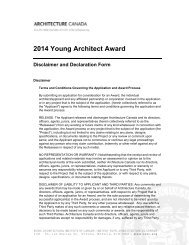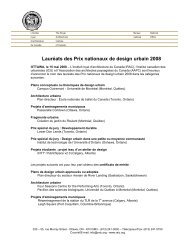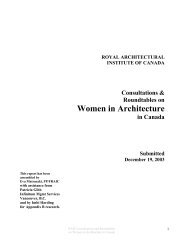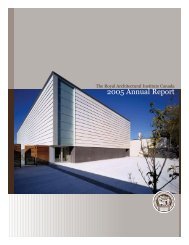Benchmark Study on Green Buildings - Royal Architectural Institute ...
Benchmark Study on Green Buildings - Royal Architectural Institute ...
Benchmark Study on Green Buildings - Royal Architectural Institute ...
Create successful ePaper yourself
Turn your PDF publications into a flip-book with our unique Google optimized e-Paper software.
network of stakeholders and partners to build the capacity of Canadian clean-technology<br />
entrepreneurs, helping them form strategic relati<strong>on</strong>ships, formalize their business plans,<br />
and build a critical mass of sustainable development capability in Canada. SDTC draws<br />
from an investment fund of $550 milli<strong>on</strong> to finance approved projects.<br />
Funding Guide for Internati<strong>on</strong>al Science and Technology Cooperati<strong>on</strong> (FGISTC):<br />
The Funding Guide for Internati<strong>on</strong>al Science and Technology Cooperati<strong>on</strong> (FGISTC) is<br />
run by the Government of Canada and is a database of various programs and incentives<br />
that promote scientific and technological R&D. With increasing globalizati<strong>on</strong> and<br />
internati<strong>on</strong>al opportunities for research, the process of identifying potential sources of<br />
funding for a project can be a time c<strong>on</strong>suming exercise. In an attempt to mitigate this<br />
problem, the FGISTC is designed to encourage, facilitate, and promote basic and applied<br />
research by Canadian researchers and scientists through the provisi<strong>on</strong> of a simple,<br />
thorough, <strong>on</strong>e-stop guide outlining the various support mechanisms for Canadian R&D.<br />
The Guide is divided into three secti<strong>on</strong>s: Grants and Bursaries; Post-doctoral fellowships;<br />
and Major internati<strong>on</strong>al prizes. The grants and bursaries can be accessed directly by<br />
research scientists, and indirectly, such as by project partners or university applicants.<br />
This secti<strong>on</strong> is the <strong>on</strong>e which supports green building R&D to the greatest extent, because<br />
like many other federal government initiatives, it provides financial support for emerging<br />
technologies that have the potential to revoluti<strong>on</strong>ize not <strong>on</strong>ly the green building<br />
movement, but the entire sustainability initiative as well.<br />
Office of Energy Research and Development (OERD) programs (PERD, T&I R&D, CES,<br />
BET):<br />
The Office of Energy Research and Development (OERD) is an initiative by NRCan<br />
which manages and funds two main energy R&D programs, the Program of Energy<br />
Research and Development (PERD) and the Technology and Innovati<strong>on</strong> Research and<br />
Development (T&I R&D) Initiative. The Program of Energy Research and Development<br />
(PERD) funds research and development designed to ensure a sustainable energy future<br />
for Canada in the best interests of both our ec<strong>on</strong>omy and our envir<strong>on</strong>ment. It directly<br />
supports energy R&D c<strong>on</strong>ducted in Canada by the federal and provincial governments,<br />
and is c<strong>on</strong>cerned with all aspects of energy supply and use. PERD currently funds 26<br />
energy R&D programs. Please visit<br />
http://www2.nrcan.gc.ca/ES/OERD/english/View.asp?x=1318 for a complete list of<br />
PERD-funded programs. The Technology and Innovati<strong>on</strong> Research and Development<br />
(T&I R&D) Initiative was established in 2003 to advance promising greenhouse gas<br />
(GHG) technologies through R&D. The T&I R&D budget is $115 milli<strong>on</strong> over five years.<br />
The OERD provides T&I R&D funds directly to partner departments and agencies, which<br />
then team up with provinces, the private sector and/or universities. To achieve significant<br />
GHG reducti<strong>on</strong>s in the near term, T&I R&D aims to ensure that clean technology opti<strong>on</strong>s<br />
which provide incremental advances are brought into the energy ec<strong>on</strong>omy as quickly as<br />
possible, e.g. vehicles with reduced fuel c<strong>on</strong>sumpti<strong>on</strong>, energy-efficient buildings. In the<br />
medium to l<strong>on</strong>ger term, bridging technologies will pave the way for the transiti<strong>on</strong> to a<br />
low-emissi<strong>on</strong> energy future but will need financial support for bringing them to the<br />
market-ready stage, e.g. hybrid vehicles, technologies to access unc<strong>on</strong>venti<strong>on</strong>al oil and<br />
gas supplies. Transformative or “next generati<strong>on</strong>” technologies will eventually take us<br />
62

















